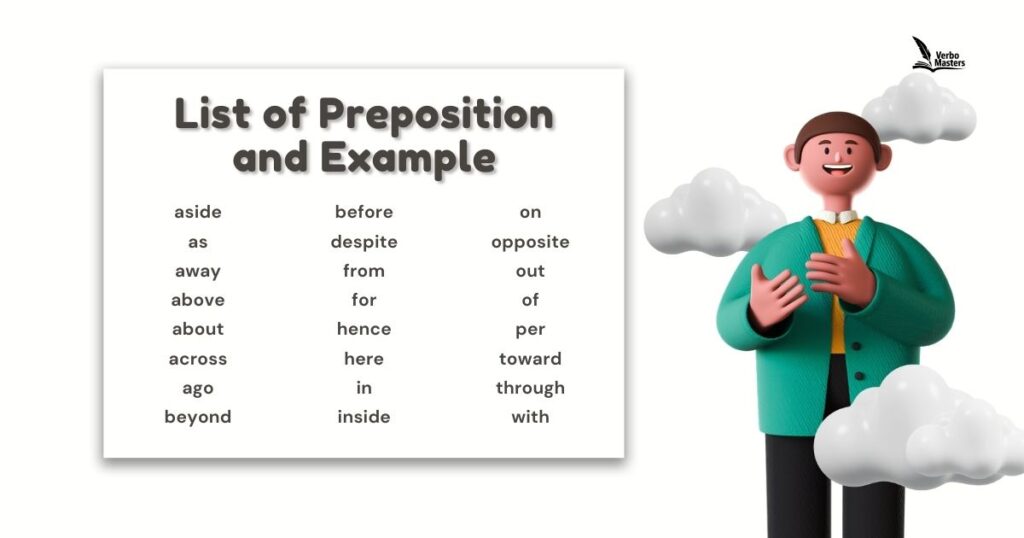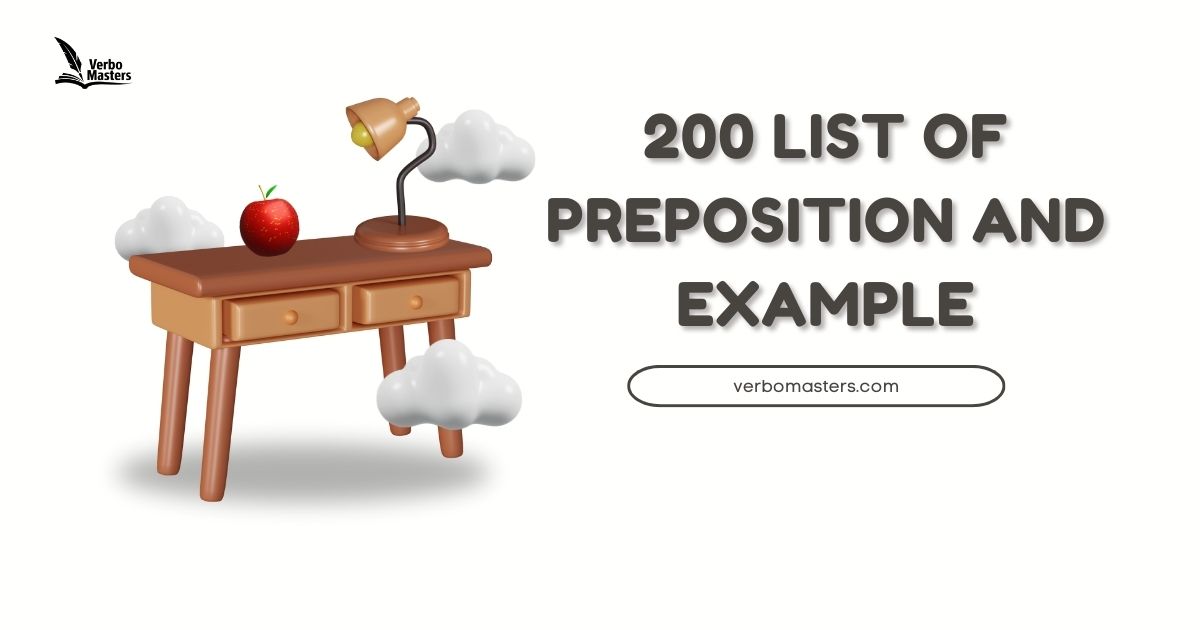Prepositions are essential words in the English language that show relationships between nouns or pronouns and other words in a sentence. They help explain direction, place, time, and manner. For example, “on,” “in,” “under,” and “between” are common prepositions. Using prepositions correctly is key to making your sentences clear and understandable.
In this list, we’ll explore 200 prepositions, each paired with an example sentence to show how they are used. Understanding prepositions will not only improve your grammar but also enhance your communication skills. Let’s dive into this comprehensive guide to prepositions!
You can also read; 200 Collective Nouns Definition and Example
List of Preposition and Example

A list of 200 prepositions, each paired with an example sentence:
- About – She was talking about her trip.
- Above – The plane flew above the clouds.
- Across – He swam across the river.
- After – We went for a walk after dinner.
- Against – The car was parked against the wall.
- Along – They walked along the beach.
- Among – She found her keys among the pile of books.
- Around – We sat around the fire.
- As – He works as a teacher.
- At – We met at the café.
- Before – Finish your homework before dinner.
- Behind – The dog is hiding behind the door.
- Below – The treasure is buried below the tree.
- Beneath – The cat is sleeping beneath the table.
- Beside – She sat beside her friend.
- Between – The ball rolled between the chairs.
- Beyond – The forest stretches beyond the hill.
- By – The book is by the window.
- Close to – The store is close to my house.
- Concerning – We had a discussion concerning the project.
- Despite – Despite the rain, we went hiking.
- Down – She climbed down the ladder.
- During – We had lunch during the break.
- Except – Everyone except Tom came to the meeting.
- For – This gift is for you.
- From – She came from the market.
- In – The book is in the bag.
- Inside – The kids are playing inside the house.
- Into – She jumped into the pool.
- Like – He looks like his father.
- Near – There is a park near my house.
- Next to – The bank is next to the grocery store.
- Of – A cup of coffee would be nice.
- Off – The cat jumped off the table.
- On – The book is on the shelf.
- Onto – She climbed onto the roof.
- Opposite – The restaurant is opposite the museum.
- Out – The dog went out for a walk.
- Outside – The children are playing outside.
- Over – The bird flew over the trees.
- Past – He walked past the old building.
- Since – They have been friends since childhood.
- Through – He walked through the door.
- Throughout – The news spread throughout the country.
- Till – Wait till I come back.
- To – She went to the store.
- Toward – The car is heading toward the city.
- Under – The cat is hiding under the bed.
- Underneath – The key is underneath the mat.
- Until – He waited until the bell rang.
- Up – She walked up the stairs.
- Upon – The decision was made upon his arrival.
- With – She came with her friends.
- Within – The answer lies within the question.
- Without – We can’t live without water.
- According to – According to the report, the results are positive.
- Ahead of – The car is moving ahead of us.
- Apart from – Apart from the rain, the weather was perfect.
- As well as – He sings as well as plays the guitar.
- At the bottom of – The ball is at the bottom of the stairs.
- At the top of – The flag is at the top of the pole.
- Because of – He was late because of the traffic.
- By means of – The message was sent by means of email.
- Due to – The game was canceled due to the rain.
- In addition to – In addition to her studies, she works part-time.
- In front of – The car stopped in front of the building.
- In place of – She used honey in place of sugar.
- In spite of – In spite of the challenges, he succeeded.
- Instead of – He chose tea instead of coffee.
- Near to – The hospital is near to my house.
- On top of – There is a book on top of the table.
- Out of – The child ran out of the room.
- Prior to – We had breakfast prior to leaving.
- With regard to – With regard to your question, here is the answer.
- Within reach of – The store is within reach of my home.
- In case of – In case of an emergency, call 911.
- In terms of – In terms of performance, she did great.
- On behalf of – She spoke on behalf of the team.
- On top – He placed the cup on top of the table.
- Out of sight of – The car was parked out of sight of the security cameras.
- In front – The dog sat in front of the door.
- Inside of – The documents are inside of the drawer.
- Near the edge of – The table is near the edge of the room.
- On the side of – He is sitting on the side of the stage.
- Out of reach – The book is out of reach for the child.
- Outside of – The office is located outside of the city center.
- Under the influence of – He was under the influence of alcohol.
- In accordance with – The plan was implemented in accordance with the rules.
- In case – In case it rains, bring an umbrella.
- On account of – The school was closed on account of the snow.
- With respect to – With respect to the new guidelines, we will proceed.
- As of – As of today, we are no longer accepting new applicants.
- In relation to – The article is in relation to current events.
- In the direction of – We are traveling in the direction of the city.
- On the part of – It was a kind gesture on the part of the team.
- Out of consideration for – He stayed silent out of consideration for others.
- In line with – The design is in line with the latest trends.
- On the verge of – The project is on the verge of completion.
- With the exception of – With the exception of John, everyone was present.
- In the vicinity of – The restaurant is in the vicinity of the park.
- By virtue of – She won by virtue of her hard work.
- For the sake of – They did it for the sake of their children.
- In response to – The company replied in response to the inquiry.
- On the basis of – His promotion was based on the basis of his performance.
- With the help of – He finished the task with the help of his colleagues.
- In the middle of – We stopped in the middle of the road.
- In place of – He served in place of his father during the ceremony.
- In relation to – The costs are in relation to the market rate.
- On the contrary – He thought it was difficult, on the contrary, it was easy.
- On behalf of – She accepted the award on behalf of the team.
- At the expense of – The team succeeded at the expense of their health.
- In addition to – In addition to his job, he volunteers at the shelter.
- In case of – In case of fire, use the exit doors.
- By way of – The gift was sent by way of a courier.
- In line with – The decision is in line with our company policy.
- With regard to – With regard to your question, we will reply soon.
- In the event of – In the event of an emergency, dial 911.
- At the expense of – The project was completed at the expense of quality.
- On top of – There’s a red hat on top of the shelf.
- With the help of – She solved the puzzle with the help of her friend.
- In favor of – I am in favor of the new proposal.
- By means of – The task was completed by means of teamwork.
- In front of – He stood in front of the crowd.
- On the side of – There’s a little shop on the side of the road.
- At the request of – The documents were sent at the request of the manager.
- With regard to – With regard to the meeting, we have postponed it.
- In light of – In light of recent events, the decision was changed.
- With reference to – With reference to your email, we have reviewed the proposal.
- In place of – He worked in place of his colleague who was absent.
- On the part of – The mistakes were made on the part of the team.
- In favor of – The board voted in favor of the new policy.
- For the sake of – They did it for the sake of their children’s future.
- In response to – He replied in response to her question.
- With the exception of – Everyone, with the exception of Tim, passed the exam.
- At the time of – At the time of his arrival, the meeting was almost over.
- On account of – We delayed the event on account of bad weather.
- In conjunction with – The project was done in conjunction with two companies.
- In the course of – In the course of the meeting, we discussed several ideas.
- In relation to – The results are in relation to the previous study.
- For the benefit of – This new feature is designed for the benefit of our customers.
- In connection with – The police questioned him in connection with the robbery.
- At the hands of – The painting was restored at the hands of a skilled artist.
- In view of – In view of the circumstances, we decided to postpone the event.
- In addition to – In addition to the salary, employees get bonuses.
- In the light of – In the light of recent events, the company changed its policy.
- By the time – By the time we reached the station, the train had left.
- Out of sight – The car was parked out of sight of the security camera.
- At the hands of – The leader was defeated at the hands of the opposition.
- In the face of – In the face of adversity, she remained strong.
- In line with – The new design is in line with current trends.
- By way of – We communicated by way of email.
- In the midst of – In the midst of the chaos, she stayed calm.
- At the time of – He arrived at the time of the meeting.
- With respect to – With respect to the issue, we have made a decision.
- In keeping with – The event was planned in keeping with the company’s theme.
- At the bottom of – The keys were found at the bottom of the bag.
- By means of – She completed the task by means of her smartphone.
- In the middle of – She was in the middle of a conversation when I arrived.
- In front of – The car parked in front of the house.
- In addition to – He plays guitar in addition to singing.
- For the purpose of – The course is designed for the purpose of improving skills.
- On the part of – There was a misunderstanding on the part of the organizers.
- In support of – They rallied in support of the new law.
- At the back of – The kitchen is at the back of the house.
- With a view to – The company is investing with a view to expanding its market.
- With regard to – We would like to clarify with regard to your question.
- In light of – In light of the circumstances, we decided to proceed.
- At the bottom of – The cat was hiding at the bottom of the stairs.
- On behalf of – She accepted the award on behalf of her team.
- In place of – The flowers were placed in place of the vase.
- In accordance with – The meeting was held in accordance with the schedule.
- By virtue of – She won the contest by virtue of her hard work.
- On the eve of – The company launched the product on the eve of the event.
- With respect to – With respect to your request, we will take action soon.
- In the course of – The issue was resolved in the course of the meeting.
- In the direction of – The car is heading in the direction of the airport.
- In relation to – His comments were in relation to the new policy.
- On the occasion of – The celebration was held on the occasion of the anniversary.
- In case of – In case of an emergency, dial the number provided.
- For the sake of – He took the risk for the sake of his family.
- In response to – He replied in response to her message.
- In view of – In view of recent changes, we need to adjust the plan.
- With the exception of – Everyone attended the meeting with the exception of John.
- At the request of – The documents were sent at the request of the manager.
- In connection with – The police questioned him in connection with the crime.
- In support of – The crowd cheered in support of the team.
- At the mercy of – The town was at the mercy of the storm.
- In line with – The rules are in line with the current guidelines.
- By the end of – The work should be finished by the end of the day.
- In the middle of – She was reading in the middle of the park.
- In the process of – We are in the process of completing the project.
- With the intention of – She started the business with the intention of helping others.
- In light of – In light of the recent developments, we need to act quickly.
- In advance of – The meeting was scheduled in advance of the deadline.
- At the height of – The company expanded at the height of the economic boom.
- In contrast to – The new design is modern in contrast to the old one.
- In relation to – The response was in relation to the request.
- In honor of – A statue was built in honor of the founder.
- On the grounds of – He was dismissed on the grounds of misconduct.
- With regard to – With regard to your inquiry, we will provide an update soon.
This list includes a wide range of prepositions with examples to show their usage. Prepositions help clarify relationships between different parts of a sentence!
FAQs
What is a preposition?
A preposition is a word that shows the relationship between a noun or pronoun and another word in the sentence. It often indicates location, direction, or time.
How do prepositions function in sentences?
Prepositions link nouns or pronouns with other words in the sentence to show their relationship. They clarify where, when, or how something happens.
Can a sentence have more than one preposition?
Yes, a sentence can contain multiple prepositions, each showing different relationships. For example: “She walked through the park and into the store.”
What are some common prepositions?
Some common prepositions include “in,” “on,” “at,” “by,” “with,” “under,” “over,” and “between.” These are used to show relationships in various contexts.
What is the difference between a preposition and a conjunction?
A preposition shows the relationship between a noun/pronoun and another word, while a conjunction connects words, phrases, or clauses. For example, “and” is a conjunction, and “on” is a preposition.
Are there prepositions that show time?
Yes, prepositions like “at,” “on,” “in,” and “during” are often used to indicate time. For example, “I will meet you at 3 p.m.” or “She left on Monday.”
Can prepositions be used at the end of a sentence?
Yes, prepositions can appear at the end of a sentence, particularly in questions or phrasal verbs. For example: “What are you looking for?” or “Where are you coming from?”
Are prepositional phrases important?
Yes, prepositional phrases are crucial in English as they give more information about time, place, direction, or manner. For example: “The book is on the table.”
Can prepositions be part of phrasal verbs?
Yes, prepositions often combine with verbs to form phrasal verbs. For example, “look up,” “turn off,” and “give in” all contain prepositions that alter the meaning of the verb.
How can I learn to use prepositions correctly?
To use prepositions correctly, practice reading and writing sentences while paying attention to how prepositions are used. It also helps to learn common preposition combinations in phrases and contexts.
Conclusion
Prepositions are essential words in English grammar that connect nouns or pronouns to other words in a sentence. They help clarify relationships such as location, time, and direction. For example, “The book is on the table” shows the position of the book.
Learning prepositions is key to mastering sentence structure. They give important details that make communication clearer. Whether it’s time, place, or movement, prepositions help specify meaning in everyday speech and writing.

I’m John Smith, a language enthusiast dedicated to helping writers, students, and professionals master the art of clear and effective communication. Whether you’re looking for grammar tips, writing guides, or common mistake corrections, you’ll find valuable insights to improve your language skills. Let’s make grammar simple and fun!

